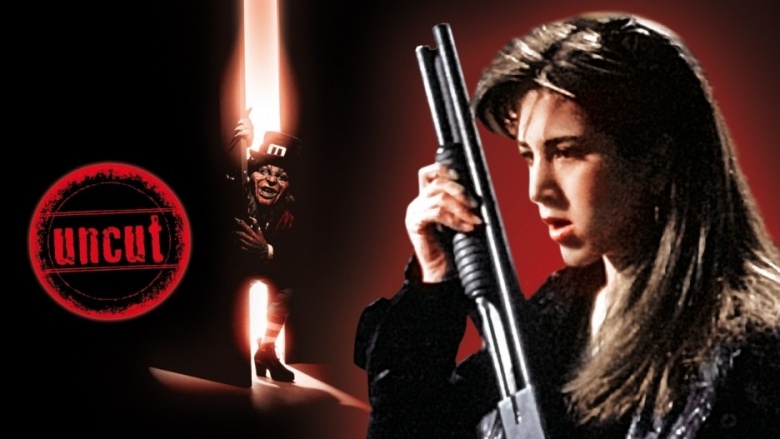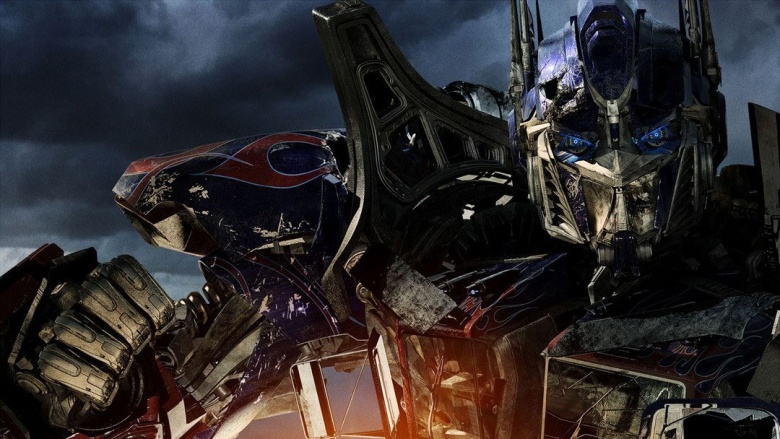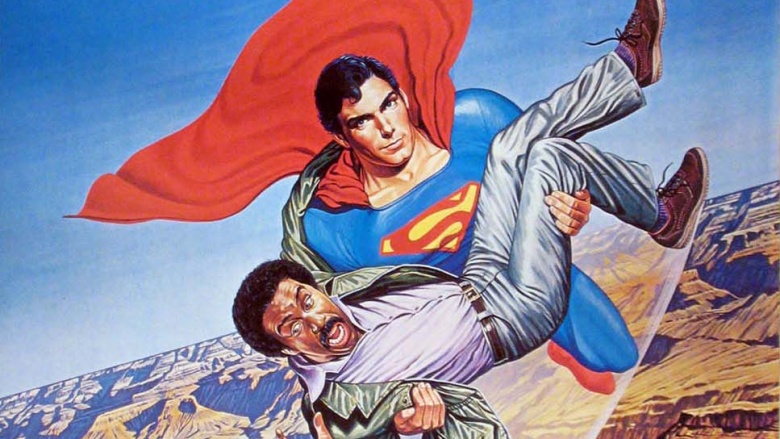How These Terrible Movies Managed To Get Sequels
Every moviegoer knows what sequel fatigue feels like. It seems like the modern movie world is almost nothing but a sea of sequels and remakes, lending validity to the old joke about there only being seven scripts in Hollywood. Oftentimes, these sequels seem like no-brainers, such as when a movie scores a home run with its box office and its critical reviews. Every now and then, though, an objectively terrible movie still manages to spawn a sequel, making you wonder just what happened.
Ghost Rider
Somewhere along the way, Ghost Rider became the go-to example for "terrible superhero movie." That's actually something of an achievement in and of itself, as this Nicholas Cage film edges out such awful fare as Spider-Man 3 and Howard the Duck to be the exemplar of superhero films done poorly. Nonetheless, this movie had exactly one sequel: Ghost Rider: Spirit of Vengeance, which ended up being both a critical flop and a commercial disappointment, despite grossing more than twice its budget. (It helped that its budget was nearly half of the first film's.) Why, though, did the terrible first movie get a sequel at all?
The short answer, as is often the case, is money. While the first Ghost Rider movie was not nearly as profitable as official entries in the Marvel Cinematic Universe would be, it had a surprisingly decent showing in foreign markets. So on a budget of $110 million, the movie ended up grossing over $228 million. Even with the cost of advertising eating into that, the cinematic powers-that-be decided the flame-skulled hero had franchise potential. It didn't hurt that the first movie debuted in 2007, a full year before Marvel completely changed the landscape with the first Iron Man movie. Ghost Rider didn't really have much superhero competition, and the competition he had was pretty lackluster. When the sequel came out in 2012, it grossed far less money because audiences had become spoiled with the quality of the Marvel Cinematic Universe. On the bright side, the failure of this sequel is why Marvel secured the rights to Ghost Rider, leading to his Agents of S.H.I.E.LD. appearances.
Pirates of the Caribbean: On Stranger Tides
The first Pirates of the Caribbean movie was a film that defied all odds. Many people scoffed when they heard there would be a cinematic adaptation of the famous Disney theme park ride. It seemed unlikely the movie would be anything more than an advertisement, and its source material wasn't exactly heavy in rich, narrative potential. And the initial sight of the talented Johnny Depp as a manic ham caked in makeup seemed to signal this would be, at best, a spectacle. And then the movie proved itself to be full of unforgettable characters, captivating performances, and an engaging plot. Because of this success, the first movie became a trilogy. Many people thought the trilogy was already stretching the premise of these movies quite thin, but this didn't stop On Stranger Tides from being released.
And so, a franchise already burdened with too many sequels got another sequel, even though it was missing many of the principle players from the original movies. And that sequel itself warranted another movie: Dead Men Tell No Tales. Surprisingly, this 2011 movie had been in some form of pre-production for years. Back when the first two sequels to the first movie were filming, the writers of those movies learned about the novel On Stranger Tides, written by Tim Powers. They felt the book would be a shoo-in to adapt into a new adventure for Captain Jack Sparrow. And despite the skepticism that many felt at a redundant return to the silver screen for Sparrow, the movie ended up being (as of this writing) the 19th highest-grossing film of all time (not adjusted for inflation), due in no small part to its stellar overseas performance. And this, of course, is why Dead Men Tell No Tales was greenlit, as there's apparently still hidden treasure for the movie studio to find with these films.
Leprechaun
Certain horror movie villains seem destined for greatness as soon as they debut. Characters like Jason Voorhees and Freddy Krueger instantly stamped themselves onto the public consciousness and have remained there ever since. Other horror villains are less memorable, and the titular Leprechaun is certainly one such villain. As the name implies, the villain is an evil leprechaun who sets out to murder those he feels has stolen his gold. The movie tries to blend horror and comedy and fumbles on both in an absolute critical disaster. In fact, one of the most memorable things about it is that it was one of Jennifer Aniston's worst performances. This is understandable because it was her first movie, though she would be forgiven for striking this particular flick from her resume.
The critically panned Leprechaun movie spawned five sequels, including such memorable titles as Leprechaun 4: In Space and Leprechaun in the Hood. Why? Profit is relative. If you look at the film's gross of $8.6 million, it seems rather meager, even adjusting for the fact that this was 1993. However, the movie was produced for less than $1 million, so the movie brought in over eight times what it cost to create. From a studio perspective, it makes perfect sense to crank out a series of low-budget moneymakers instead of trying to create a risky, big-budget blockbuster.
Transformers: Revenge of The Fallen
While far from perfect, the first Transformers movie managed to capture much of the creative imagination at the heart of the Transformers. For instance, the sheer wonder of walking and talking machines, the grandeur of an ancient alien war, the terror of the humans caught in the midst of an interplanetary conflict — director Michael Bay was able to bring all this to life. And then there was the sequel movie, Revenge of the Fallen. The movie was a hot mess on all fronts, from amping up the forced humor of the human characters to adding bizarre mysticism and character resurrections on top of introducing highly confusing origins for confounding new characters like The Fallen. All of this is in addition to offensive portrayals like Skids and Mudflap, who are quite literally jive-talking racist stereotypes. Despite all of this, the Transformers franchise continued with the destruction gorefest Dark of the Moon.
Why create a sequel to a movie franchise that was running on steam and completely unable to transform itself into anything innovating or exciting? Despite the critics excoriating the film, it ended up being the second-highest grossing movie of 2009. To put this in perspective, it out-grossed fan favorites like Harry Potter and the Half-Blood Prince, as well as critical darlings like Up and the much-buzzed-about cinematic reboot of the Star Trek universe. From a studio standpoint, creating more sequels was an absolute no-brainer. Viewers with a brain, however, would likely have preferred if Michael Bay's movie had simply transformed into a couple hours of paint drying.
Underworld: Rise of the Lycans
The Underworld movies have had an interesting history. The first movie premiered in 2003, and it brought a vivid world of vampires to the silver screen well before anyone was gushing about Bella and Edward. This modern goth fest featured an ongoing war between vampires and werewolves (known as Lycans) and heavily featured the protagonist, Selene, played memorably by Kate Beckinsale. She also headlined the inevitable sequel to the first movie, which continued to chronicle changes in the relationships between vampires and werewolves. However, the follow-up to this movie was not another sequel but instead a prequel that focused on how the whole vampire/werewolf beef began in the first place. This movie had a lot going against it, from the absence of Kate Beckinsale in a catsuit to audience wariness of prequels. Nonetheless, it led to a sequel movie that continued Beckinsale's vampy ventures. Why, though, did that sequel get made at all?
The likeliest answer is that the movie studio realized audiences wanted to see Kate Beckinsale first and foremost. Counting worldwide profits, Rise of the Lycans wasn't as grim as it could have been: it grossed over $91 million, which is pretty good for its $35 million budget. However, both its domestic and worldwide profits were lower than any other Underworld movie released to date. For better or for worse, Rise of the Lycans had always been an extended "extras" kind of movie, with the filmmakers intending to return to the story of Beckinsale's Selene to finish out the trilogy (and then some). Once they did, the sequel earned nearly $16 million more than its predecessor, which was enough to restore faith in the idea of Underworld as an ongoing franchise.
Fantastic Four (2005)
While Ghost Rider may have the lock as the go-to reference for "worst superhero movie," the first Fantastic Four movie is a close second. Despite featuring Marvel's "first family" of adventuring superheroes, the movie failed to truly highlight either the family dynamic that unites the main characters or the fabulous abilities they use to save the city (and, on occasion, the planet). The movie currently sits at 27 percent on Rotten Tomatoes, with critics noting the bad attempts at humor, mediocre story, and subpar performances from the actors. Despite the hate from mainstream critics and comics superfans alike, the movie received a sequel in the form of the Rise of the Silver Surfer movie.
So how in the name of Yancy Street did this sequel get the green light? This movie, like others on this list, did not receive as much profit as the studio would have liked, but it was still profitable overall, grossing over $330 million against its budget of $100 million. And the movie came out in 2005, before Marvel's official movies dominated the superhero landscape, so the studio likely saw the potential to create a superhero franchise that could capture audience imaginations. But the sequel was "one step forward, two steps back" for the studio, as the movie was received slightly better by professional movie critics but did poorer at the box office than its predecessor. Hence, the unfortunate decision to reboot the entire series into a movie that was arguably worse than the first two Fantastic Four movies combined.
Scream 3
When it premiered, the first Scream movie completely revolutionized the horror genre. One of the ways it did this was by presenting characters who were as genre-aware as their audiences, keenly aware of the "rules" of horror films even as the film they are in cleverly subverted various audience expectations. Scream was a commercial and critical success and spawned two sequels relatively close together. However, while Scream 3 was a commercial success, critics were not kind to it at all, noting that the movie franchise had become as tired and cliche as the movies it once mocked. Nonetheless, it led to Scream 4 being made a whopping 11 years after the credits rolled for Scream 3. Why bother to create a sequel so far down the road?
One of the primary reasons is that they were able to get the band back together. The original Scream was a labor of love between Nightmare On Elm Street helmer Wes Craven and veteran writer Kevin Williamson. Williamson did not write Scream 3, and Craven implicitly acknowledged the impact of his absence by noting in an interview that he would only return to Scream if there was a script as good as the first movie. For Scream 4, the stars aligned, with Williamson producing a script that Craven liked and the rest of the actors being game to return to the world of Ghostface. The result was a somewhat mixed film, with critics and audiences certainly not thinking it was as good as the original but pretty unanimously agreeing it was better than Scream 3. However, a low bar benefits everyone.
Lake Placid
Depending on your tastes, Lake Placid either fails as a straightforward horror movie or succeeds as its own ironic take on the genre. It's basically a low-rent Jaws ripoff that replaces the menacing shark with crocodile who has a taste for human flesh, and the beach is replaced with the titular Lake Placid. The movie was commercially successful but heavily criticized for failing to truly land as either a scary horror movie or a funny schlock-fest. Nonetheless, it ended up generating three separate sequels and a crossover film with the equally-inexplicable Anaconda franchise. So, how the hell does this happen?
The answer to this is pretty straightforward: all those sequels were made-for-TV SyFy movies. This gave the studio the excuses they needed to hire a more affordable cast, to shoot in more affordable locations, and to basically cut costs in a way that only SyFy creature features can. And while those sequels were hated by critics and audiences alike even more than the first movie, the blunt truth is that SyFy has spent years of a "quantity, not quality" approach to filmmaking, and they easily recoup their budget by re-running these terrible monster movies ad nauseum. If you want to really be terrified, you can watch these sequels and think about how this is what SyFy spends money on instead of making something as awesome as Battlestar Galactica.
Superman 3
If Star Trek IV will forever be known as "the one with the whales," Superman 3 is the movie forever known as "the one with Richard Pryor." While it still featured the singular Christopher Reeve as the Man of Steel, the movie had many misplaced elements of camp and forced attempts to be funny. On top of that, there were scenes that might be downright alarming to younger viewers. These scenes ranged from Superman binge drinking, "good" Superman having to murder his evil side (no, we're not talking about Henry Cavill's Superman), and a woman transforming into a cyborg (who is promptly blown up by Superman). Compared to previous Superman movies, this film disappointed both critically and commercially. Hollywood's response? "Sequel!"
Being a financial disappointment is a far cry from not being profitable, and the movie made nearly $60 million back on its approximate budget of $39 million. Plus, Superman was already an industry unto himself, with these big-budget movies coming out at a time when they were the only blockbuster superhero movies in town. Even a moderate failure of a Superman movie was going to help sell action figures, lunchboxes, and so on. They rolled the dice with one more Superman movie, The Quest for Peace, which was absolutely savaged by critics and completely flopped at the box office. The sequel came out in 1987, and its disappointing performance is yet another reason Warner Bros. decided to focus on Batman movies two years later.
Alien vs. Predator
Both the Alien and Predator movies have dealt with diminishing returns over the years. While the first Alien movie redefined horror and Aliens redefined sci-fi action, movies like Alien 3 and Alien: Resurrection did irreparable damage to the brand of these movies with their muddled plots, bad performances, and inability to do anything new with the franchise. Similarly, the first Predator movie worked very well as "man vs. alien" in a rumble in the jungle, and if nothing else, that movie will live on in memes forever for its many quotable moments. But Predator 2 fizzled. Nonetheless, based on the successful Dark Horse Comics of the same name, the first Alien vs. Predator movie was created to pit the titular beasts against each other. It was predictably bad, and currently sits at 21 percent on Rotten Tomatoes, with the commentary "Gore without scares and cardboard cut-out characters make this clash of the monsters a dull sit."
Why did this gore-de-bore get a sequel? Like most awful sequels, it turned a profit, making over $172 million worldwide against its modest $60 million budget. Second, its PG-13 nature meant this movie and its sequel were an opportunity to convert younger people into fans of these franchises. Finally, the franchises were still working on other movies, such as ideas for a fifth Alien movie and the Ridley Scott vehicle that would eventually become Prometheus. As long as they weren't commercial flops, these movies served the valuable function of keeping the idea of Alien and Predator in the public consciousness long enough for future solo movies to do well at the box office.










